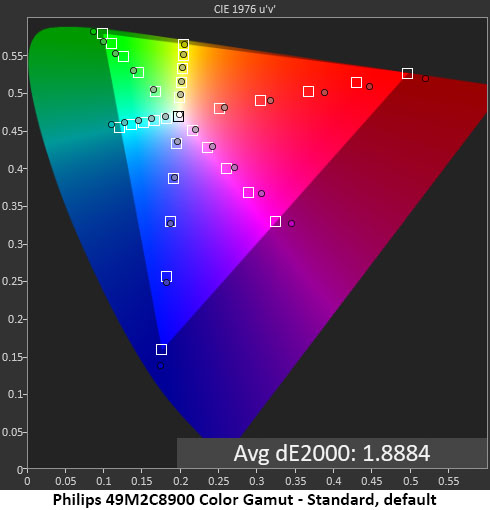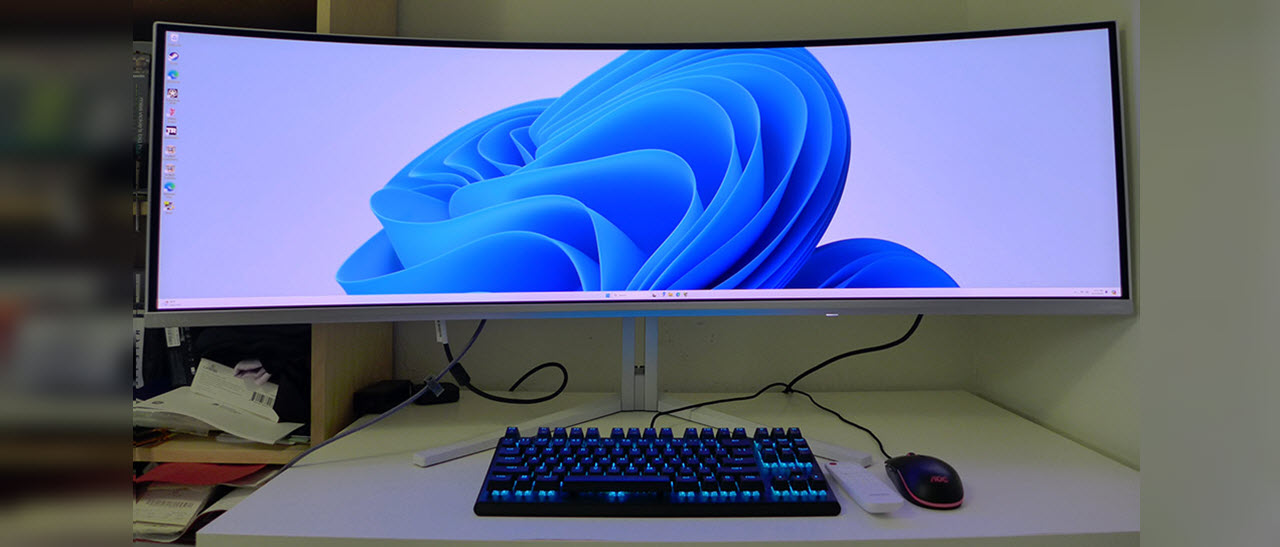Why you can trust Tom's Hardware
The 49M2C8900 has 10 total picture modes. Standard affords the option of color temp and gamma presets but there are no RGB sliders. Luckily, it’s calibrated at the factory and my sample measured up to its claims.
Grayscale and Gamma Tracking
Our grayscale and gamma tests use Calman calibration software from Portrait Displays. We describe our grayscale and gamma tests in detail here.


The 49M2C8900’s default grayscale tracking test is visually perfect, with all errors below 2dE. 3dE is considered the point where issues are visible to the naked eye. Gamma is slightly wonky with a dip from 10-30% and again at 90%. This is due to luminance values that are too high. Some shadow detail is a tad lighter than it should be. The overall average isn’t too far off, but if you want to compensate, the 2.4 gamma preset is a reasonable compromise.
If you turn the sRGB option on, the gamut shrinks correctly, and grayscale tracking is unaffected. But the gamma at 10 and 20% drops even further, making shadow areas grayer. If you want to run sRGB color, I recommend selecting the 2.4 gamma preset to get that contrast back.
Comparisons




The 49M2C8900 has the best out-of-box grayscale tracking with a very good 1.34dE score. When the other monitors are calibrated, it drops to fifth place, but since the error is completely invisible, it’s a wash. Viewed side by side, there are no visual differences in grayscale tracking between any of the screens.
The group’s gamma tracking is close as well. The 49M2C8900 has slight shadow anomalies, but they will be hard to spot in content. Its deviation of 1.82% represents an actual value of 2.16. The 0.19 range of values is mainly due to the dip I observed in the darker luminance steps.
Color Gamut Accuracy
Our color gamut and volume testing use Portrait Displays’ Calman software. For details on our color gamut testing and volume calculations, click here.
Get Tom's Hardware's best news and in-depth reviews, straight to your inbox.


I seriously doubt anyone will complain about the 49M2C8900’s color accuracy. You can see that it’s very saturated with extra verve in all six colors. There are no visual errors here, but the large gamut coverage is plain to see. Tracking is linear and on its hue targets, so nothing will look un-natural.
In the sRGB chart, you can see some slight undersaturation in red and blue, but the other colors are on target. These are very minor errors, and the 49M2C8900 is still qualified for color-critical work in both color spaces.
Comparisons


The 49M2C8900 sits fourth in a very color-accurate group of monitors. There are no visual issues with any of them, and at 1.89dE, you can use the Philips for color grading and mastering work. Remember that no calibration has been performed like the other monitors. This is excellent performance.
When comparing OLED’s color volume, Quantum Dots will always win the day. You can see the clear divide between the top three and the rest. The 49M2C8900 along with the Aorus and Asus screens are within a hair of each other at over 114% coverage of DCI-P3. The rest make do with just under 100%. While this difference is small in practice, it is visible. The main bonus with QD-OLEDs is their higher green saturation. The 92.91% value for sRGB is due to the under-saturated red and blue primaries.
Test Takeaway: The 49M2C8900 delivers bold and vibrant color in all applications. Most users will choose the full gamut for both SDR and HDR but if you want sRGB, it’s there and fully usable. I’d have liked to see adjustable RGB sliders and better gamma tracking but these are minor nits. The Philips image is as stunning as any other OLED.
MORE: Best Gaming Monitors
MORE: How to Buy a PC Monitor
MORE: How to Choose the Best HDR Monitor
Current page: Grayscale, Gamma and Color
Prev Page Brightness and Contrast Next Page HDR Performance
Christian Eberle is a Contributing Editor for Tom's Hardware US. He's a veteran reviewer of A/V equipment, specializing in monitors. Christian began his obsession with tech when he built his first PC in 1991, a 286 running DOS 3.0 at a blazing 12MHz. In 2006, he undertook training from the Imaging Science Foundation in video calibration and testing and thus started a passion for precise imaging that persists to this day. He is also a professional musician with a degree from the New England Conservatory as a classical bassoonist which he used to good effect as a performer with the West Point Army Band from 1987 to 2013. He enjoys watching movies and listening to high-end audio in his custom-built home theater and can be seen riding trails near his home on a race-ready ICE VTX recumbent trike. Christian enjoys the endless summer in Florida where he lives with his wife and Chihuahua and plays with orchestras around the state.
-
Neilbob When your monitor is wider than your desk, you've gone too wide...Reply
Okay, I'm just being facetious here. I am so very much not the target audience for a product like this: I get pains in my neck if I turn my head too much these days. -
Hdwr_Junkie What's up with all the insane Monitor aspect ratios??Reply
32:9 is INSANE!
You can't put up a single page of a document without having to scroll vertically for half of it!
That makes monitors like this USELESS for anything but panoramic gaming.
Start making monitors with a vertical size that compliments the wideness and you'll have a resurgence in sales from people other than hardcore gamers!
16:10 was a decent aspect ratio. Productive. -
bruiners79 Reply
You've clearly never worked on a ultra wide monitor with a decent resolution.Hdwr_Junkie said:What's up with all the insane Monitor aspect ratios??
32:9 is INSANE!
You can't put up a single page of a document without having to scroll vertically for half of it!
That makes monitors like this USELESS for anything but panoramic gaming.
Start making monitors with a vertical size that compliments the wideness and you'll have a resurgence in sales from people other than hardcore gamers!
16:10 was a decent aspect ratio. Productive.
I thought they were a gimmick for gaming, and then I brought my first one (49in G9), and wow... greatest productivity gainer I've ever had. In my field of view I would have 4-5 windows open (one for coding, two web browsers testing my code; one for desktop, the other mobile), one for general web browsing (news) and the last space a film or word document / spreadsheet.
Its so good that when the 57in came out i jumped at it, as the dual 4k does improve vertical scrolling over the 49in.
Try one, you'll never look back. -
helper800 Does anyone know the exact subpixel layout for this monitor? On the Philips website it just says: RGB Q-Stripe. Does this use the gen3 QD-OLED pixels or the gen2?Reply -
halfcharlie Every. Single. Time. There's at least one if not more comments from completely utterly embarrassingly clueless people who have never used and have no need of a monitor like this and lack any critical thinking ability to compensate. The vertical resolution is the same as any other 2K screen, it's not the same as zooming in on a word document until it's as wide as the monitor, that would be obvious even to a toddler, at 100% it's a full page in Word top to bottom, like wth are you thinking.Reply
Multiple times more usable than two separate screens, even than three (which I used to have) although less real estate because there's no bezel breaks or software weirdness. I couldn't live or be productive with a regular monitor, feels like I'm trapped in a tiny cage unable to move or be efficient, constantly alt-tabbing like it's my job to hit those two keys. Disgusting. Haven't upgraded to OLED yet but can't wait, there just hasn't been a monitor that is everything I want -
Erziram Fair warning: This monitor has an HDR bug in combination with AMD cards (HDR does not trigger when using Freesync). Something that you don't come across when using nVidia cards in reviews and will probably be fixed through firmware soon, but nevertheless thought I should mention this. Brilliant screen in every other aspect.Reply -
Eximo Reply
Identical to two 16:9 screens, without a bezel in the middle. I use cheap dual 16:9 screens for work and it is fine. Having that be one screen that is also physically larger than two 1080p 24" screens is a whole other thing.Hdwr_Junkie said:What's up with all the insane Monitor aspect ratios??
32:9 is INSANE!
You can't put up a single page of a document without having to scroll vertically for half of it!
That makes monitors like this USELESS for anything but panoramic gaming.
Start making monitors with a vertical size that compliments the wideness and you'll have a resurgence in sales from people other than hardcore gamers!
16:10 was a decent aspect ratio. Productive.
They do make monitors with taller resolutions. There are a few 3840 by 2560 displays out in the wild and some weirder ones like 2560x2880.
